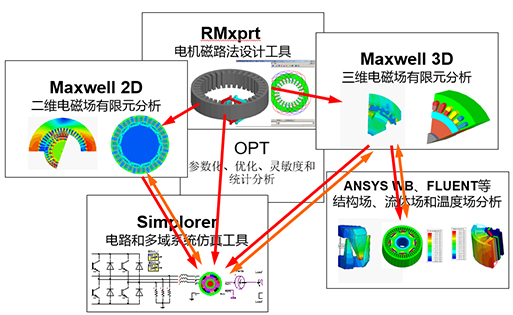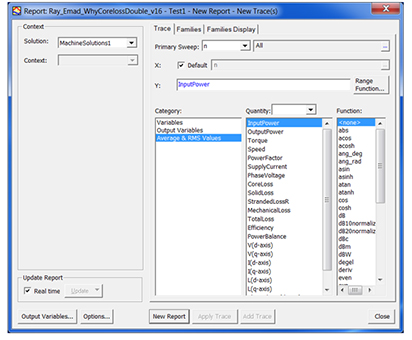Electromotor is one of the most widely-used energy conversion device, divided into two categories:generator and motor according to the energy conversion mode. The electromotor system is a complex system integrating electric, machinery, dynamic, heat dissipation, electronic circuit, control system and other disciplines.
The design of new energy electromotor is a complex multi-field physical problem, which involves many fields such as electromagnetism, structure, fluid, temperature and control.With the development of new materials, new technologies and various new electromotor technologies, the requirements of electromotor design have become more and more demanding, especially for the requirement about precision. Thus, traditional design methods and means can no longer meet the requirements of modern electromotor design. It is essentially necessary to depend on modern simulation technology to solve various design problems.
On account of the development trend of permanent magnetization, high speed, brushless electronic and digitization, integration, intelligence, high efficiency and energy saving,and other related technology challenges, ANSYS can provide with integrated design solutions and processes, in order to efficiently produce the advanced electromotor in the magnetic circuit method and the finite element, the parts and the system, the electromagnetic and multi-field, multi-level, and integrated electromotor and in the drive or control system design.

According to RMxprt, the design specialists in the electric rotating machinery based on magnetic circuit method, it’s not only possible to finish as many as 19 kinds of calculation through motor magnetic circuit method, but to instantly generate both the double-dimensional and three-dimensional parametric finite element modelings in one time, including setting up geometric model automatically, the material properties, gridding plot, boundary conditions, external circuit, movement and solutions, and so on. Moreover, a set of variables in the RMxprt’s modeling can seamlessly be transferred to Maxwell, which is better for parameterization, optimization, simplification of process in the finite element analysis of electromagnetic field and transient performance optimization.

Based on Maxwell 2D/3D, the finite element analysis software of electromagnetic field, just simple modification of RMxprt finite element model can directly lead to accomplishment of all motor electromagnetic performance analysis of normal and fault conditions, such as: the cogging torque, Open circuit counter emf, Rated load, torque current, winding short circuit/open circuit, conducting bar fracture, and so on. Besides, it can be directly set or activate a set of RMxprt variables, to parameterize/optimize all kinds of transient characteristics of the motor design. By means of HPC and DSO, the motor electromagnetic calculation and performance optimization process can also be accelerated. Combined with internal and external circuit or Simplorer circuit, after simulating and optimizing the fem model of the motor, the equivalent circuit model is output for backup.

Simplorer was used to simulate the motor and control system. Using SCADE suite, the embedded control code was generated automatically.Combined with Maxwell field coupling, transient collaborative simulation technology, the extraction technology of parasitic parameters of Q3D cable, busbar and IGBT, high precision simulation and performance optimization are carried out for the whole electric drive system.

With Maxwell outputting the geometric model of motor and distributed loss, the temperature field simulation of the motor is carried out through Mechanical/FLUENT and other tools, implementing electromagnetic and thermal single/two-way coupling analysis, in order to predict the temperature rise of the motor under various working conditions, in which the cooling system design can be optimized.

With the geometric model of motor outputted by Maxwell, the automatic coupling simulation process of electromagnetic, vibration and noise realized by Workbench and ANSYS, structural stress, deformation and vibration noise of motor under various working conditions can be conveniently analyzed.
In addition, ANSYS also provides customized development functions UDO and ToolKit to facilitate users to streamline and automate complex design. UDO can directly output various electromagnetic performance data of the motor after the finite element analysis of the electromagnetic field. 0ToolKit can instantly complete and output LdLq of permanent magnet and induction motor, efficiency Map, torque speed curve of motor, etc. Meanwhile, with the help of MPTA control algorithm, the influence of temperature, frequency variation alternating resistance, inclined groove and iron loss coefficient at different frequencies on motor performance would be fully taken into our consideration.

UDO is a post-processing tool built in Maxwell for motor design. It can directly output the input and output power, torque, speed, various losses, LdLq, efficiency, power factor and other electromagnetic performance data of the motor after the finite element calculation of electromagnetic field.

Toolkit is a custom post-processing tools built in Maxwell for motor design. It can instantly complete and output the efficiency Map graph, the loss Map graph, LdLq and current Map graph, and the torque speed curve of the permanent magnet motor. Depend on the MPTA control algorithm of maximum torque output per unit current, the temperature, frequency variable ac resistance, chute, iron loss factor at different frequencies are all considered.
